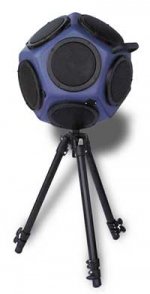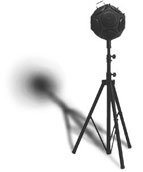Lots 😀
well, at least 12. 😉
The size and type of drivers as well as something more specific for the application(s) would be helpful in thinking up ideas.
well, at least 12. 😉
The size and type of drivers as well as something more specific for the application(s) would be helpful in thinking up ideas.
Hey, this sounds like some big money. For acoustic measurements, you probably want to get something with a very good frequency response and good dispersion.
Are you using some software to do measurements? Do you have a certain frequency range in mind? A price range?
I also hear that sometimes all 12 speakers are not driven by the same signal.. so that could also be a factor in construction Do you have something more specific than "architectural acoustics applications"?
Are you using some software to do measurements? Do you have a certain frequency range in mind? A price range?
I also hear that sometimes all 12 speakers are not driven by the same signal.. so that could also be a factor in construction Do you have something more specific than "architectural acoustics applications"?
joe carrow said:For acoustic measurements, you probably want to get something with a very good frequency response and good dispersion.
Which these usually do not have, I' have looked at about 6 systems like this, the BEST one had a frequency response quoted as 120Hz-16kHz + or - 10dB!!!
very bad, I would look into a cube using UniQ style Coaxials.
Yes, a dodecahedron requiers 12 drivers.
The main goal of such "boxes" are to emulate the behaviour of an ideal omnidirectional source (the same radiation pattern in all directions).
The useful frequency range for architectural acoustics is from 125Hz to at least 4kHz. Dodecahedron manufaturing companies assure that they babies are able to generate these frequencies and beyond even with drivers of 5.5". Shall we believe this?
http://www.norsonic.com/web_pages/available_accessories_build.html#Anchor-No-45449
http://www.aij-ai-swg.strl.nhk.or.jp/dodecahedron.html
http://www.aij-ai-swg.strl.nhk.or.jp/directivity.html
I'm not familiar managing wood to built drivers enclosures and fiberglass sounds even more dificult to manage. Can the latter material be cutted and fixed and support its own weight plus drivers'?
By the way, all drivers are fed by the same input signal (usually white or pink noise) which means that they are working in phase.
Another possibility might be to built a 3-way array like the following to generate a broader spectrum:
http://www.akustik.rwth-aachen.de/Forschung/Projekte/ela_dode
Saludos
The main goal of such "boxes" are to emulate the behaviour of an ideal omnidirectional source (the same radiation pattern in all directions).
The useful frequency range for architectural acoustics is from 125Hz to at least 4kHz. Dodecahedron manufaturing companies assure that they babies are able to generate these frequencies and beyond even with drivers of 5.5". Shall we believe this?
http://www.norsonic.com/web_pages/available_accessories_build.html#Anchor-No-45449
http://www.aij-ai-swg.strl.nhk.or.jp/dodecahedron.html
http://www.aij-ai-swg.strl.nhk.or.jp/directivity.html
I'm not familiar managing wood to built drivers enclosures and fiberglass sounds even more dificult to manage. Can the latter material be cutted and fixed and support its own weight plus drivers'?
By the way, all drivers are fed by the same input signal (usually white or pink noise) which means that they are working in phase.
Another possibility might be to built a 3-way array like the following to generate a broader spectrum:
http://www.akustik.rwth-aachen.de/Forschung/Projekte/ela_dode
Saludos
Puggie said:
Which these usually do not have, I' have looked at about 6 systems like this, the BEST one had a frequency response quoted as 120Hz-16kHz + or - 10dB!!!
very bad, I would look into a cube using UniQ style Coaxials.
Considering that there are 12 drivers with their back-waves inside the enclosure and speaker cones are often thought of as semi-transparent (acoustically)..... then you've got to worry about beaming of individual drivers, and lobing interactions between the drivers- how do you even measure something like this? at one meter? 😉
Dawas- did you say you're building
twelve measurement speakers? If so, that's 144 drivers, and 144 wood pentagons- call it 150 so you can get the best bulk pricing... I say that the ONLY way to do this is to get bids from a few wood shops, and try for MDF, or plywood. Try to get a couple of college kids to help with assembly. Oh, and definitely think of building a jig to hold these together during construction.
Also, your last link looks pretty cool- they seem to really have done their research! (pun intended) It would be possible to go from 125 hz to 4 khz, I think- but driver diameter would have to be kept low, and excursion would have to be high. Good luck finding it- Tang Band may just have something for you.
Joe
Not 12 dodecahedrons only one!
Hi Joe:
Actually my first attempt is to built only one spherical box with 12 loudspeakers. I'm not interested in large scale loudspeakers manufacturing...yet.
I will try with plywood as a first attempt and 6" drivers. This could make the boxes ligther than those with 8" found on street.
In the meantime I will start with an old (very heavy) cube with six 8" drivers that I found in my job, as a low frequency driver I will use a 15" box.
Regards
Hi Joe:
Actually my first attempt is to built only one spherical box with 12 loudspeakers. I'm not interested in large scale loudspeakers manufacturing...yet.
I will try with plywood as a first attempt and 6" drivers. This could make the boxes ligther than those with 8" found on street.
In the meantime I will start with an old (very heavy) cube with six 8" drivers that I found in my job, as a low frequency driver I will use a 15" box.
Regards
Hve you looked at the B&K OmniPower Loudspeaker Type 4296
http://www.bksv.com/1407.asp
I think this product may be liscensed from BBN.
When I was a kid, in math class, we made paper do-dec’s.
To do this we first drew circles on cardboard with a compass. We then inscribed a pentagon in the circle. The circle was cut out with a small notch at each intersect of the pentagon. This formed a template that we each used to draw twelve circles on construction paper. These circles were then cut out. The tabs between the notches representing the inscribed pentagons were then folded over forming tabs. A base pentagon would have five more pentagons attached to its tabs. The attached pentagons were then brought together to form the first 3-d section of the polyhedron.
http://www.bksv.com/1407.asp
I think this product may be liscensed from BBN.
When I was a kid, in math class, we made paper do-dec’s.
To do this we first drew circles on cardboard with a compass. We then inscribed a pentagon in the circle. The circle was cut out with a small notch at each intersect of the pentagon. This formed a template that we each used to draw twelve circles on construction paper. These circles were then cut out. The tabs between the notches representing the inscribed pentagons were then folded over forming tabs. A base pentagon would have five more pentagons attached to its tabs. The attached pentagons were then brought together to form the first 3-d section of the polyhedron.
Attachments
When did Michael Jordan take over the design office at Bose? 😀
I would think one could cut the individual face baffles out of hardwood or MDF. You could laminate two sheets of 3/4" MDF. The 1-1/2" thickness would make a great stable gluing surface for all the individual pieces once the shape and angles were just right. Gluing it together might be a challenge though, unless you do it in zero G.
I would think one could cut the individual face baffles out of hardwood or MDF. You could laminate two sheets of 3/4" MDF. The 1-1/2" thickness would make a great stable gluing surface for all the individual pieces once the shape and angles were just right. Gluing it together might be a challenge though, unless you do it in zero G.
- Status
- Not open for further replies.
- Home
- Loudspeakers
- Multi-Way
- Dodecahedron Loudspeaker

